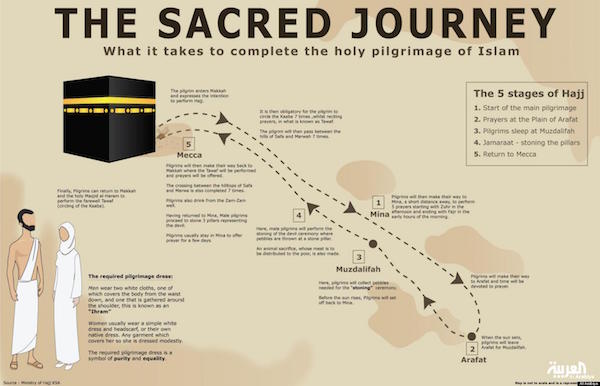
Haj is one of the five pillars of Islam and is compulsory for all able-bodied muslims who can afford it.
1. Among the world's largest gatherings, more than 3 million people participated in it in 2012.
2. Six out of 10 pilgrims to the Haj are men and more than 55 per cent come from outside Saudi Arabia. The country gives out a set number of free Haj visas every year.
3. More than 100,000 Indians participate in the Haj every year, largely from Uttar Pradesh. Air-tariff subsidies amounting to hundreds of crores are provided to the pilgrims by the Haj Committee of India (HCOI). In 2010, the Supreme Court of India directed the government to fade-out Haj subsidies over the next 10 years.

4. A recent surge in cases of Middle Eastern Respiratory Syndrome (MERS), an additional 25,000 medical professionals have been brought to Mecca for the Haj. The World Health Organisation and the Saudi government have been working closely for the last six years to prevent health hazards during this period.
Read: Holy and unsafe? Tragedies at Haj over the years
5. In the wake of widespread terror threats in the continent, Saudi authorities deployed an additional 100,000 security personnel and 5,000 additional CCTV cameras in 2015.
6. During the Haj, about 3.5 million text messages are sent to pilgrims by the Ministry of Haj in Saudi Arabia. These are to inform the correct procedures for the Haj rites in order to "prevent that which is harmful".
7. Coinciding with Eid al Adha, Haj takes place over five-days every year. It's history is closely linked to that of Hagar, Abhram's second wife, and her son Ishmael.
8. As pilgrims enter Miqat, the first point of the Hajj, they bathe and wear white robes. These robes symbolise purity and equality of all pilgrims.
9. A number of rites are performed during the pilgrimage including circling the holy Kabba seven times, sipping water from the Zam Zam well, and stoning the devil in Mina.


![Mystery Solved! Who let the dogs out [Watch]](http://images.catchnews.com/upload/2023/04/29/viral_246936_300x172.png)




![BJP's Kapil Mishra recreates Shankar Mahadevan’s ‘Breathless’ song to highlight Delhi pollution [WATCH] BJP's Kapil Mishra recreates Shankar Mahadevan’s ‘Breathless’ song to highlight Delhi pollution [WATCH]](https://images.catchnews.com/upload/2022/11/03/kapil-mishra_240884_300x172.png)

![Anupam Kher shares pictures of his toned body on 67th birthday [MUST SEE] Anupam Kher shares pictures of his toned body on 67th birthday [MUST SEE]](https://images.catchnews.com/upload/2022/03/07/Anupam_kher_231145_300x172.jpg)






